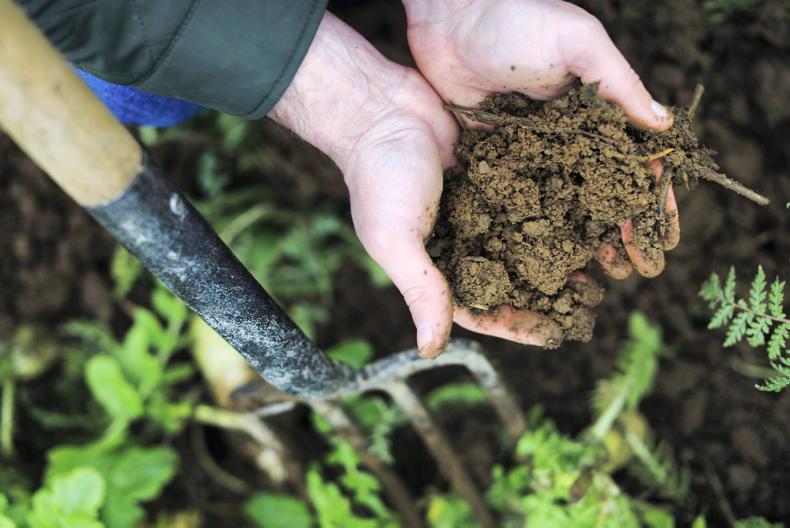Prior to the early 1980s, there was little reference to the term “regenerative agriculture”. But since then there has been an explosion of academic and other references to the term.
Ireland hasn’t been exempt from this interest. There is an European Innovation Partnership (EIP) on the topic, and a number of Irish food and drink companies including ABP and Diageo are actively championing the subject.
Relatively new developments frequently can have a polarising response. Sometimes they will get notice for a while and then interest will fade.
Other times, these ideas persist and they require deeper reflection. Regenerative farming is one such idea.
My abiding concern with any proposal to address key concerns affecting the production of food, such as sustainability, climate change, farming income and the wellbeing of farming families and, so on, is whether these proposals can stand up scientifically.
A recent report* by the European Academies’ Science Advisory Council sets out the issues that need to be considered in the appraisal of regenerative agriculture.
Sometimes it can be difficult to get the required scientific focus in general discussion.
New concepts
Advocates latch on to new concepts, often with flimsy enough credentials for their support. Sometimes the advocates for new ways of doing business take on the role of leading for what become “movements”. And, of course, when this happens, we’re outside the realms of science and it’s very difficult, if not impossible, to get beyond the theology.
The scientific approach is painstaking and takes time. Impacts are not always immediate.
Short-term, seemingly positive results, are frequently overcome in time and unexpected impacts can never be discounted.
Also, nowadays, the internet allows immediate publication and the impressive presentation of results. This can be most misleading.
An obvious example is the clamour in some quarters for farmers for several years to adopt multispecies swards (MSS).
Scientifically, we simply don’t have sufficiently robust information yet to make clear-cut recommendations, except for ryegrass-clover swards. But that hasn’t stopped the advocacy of MSS by prominent people.
Problems of persistency are apparent and, if not confronted, will undermine the potential that this approach offers. The same is likely with regenerative agriculture if we don’t allow the methodology of science to lead the way.

Gerry Boyle of Teagasc at the Beef Summit. \ Dave Ruffles
When I first encountered the term, my interest was stimulated by the need to figure out about the ability of our soils to produce food sustainably.
Our understanding of how to improve food productivity has been revolutionised by the use of chemical fertilisers in Ireland for almost 70 years.
We still have the extraordinary situation that much of our soils lack sufficient nutrients. Yet we know that excessive fertiliser use has adversely affected water quality and some of our soils are close, if not past the point of diminishing returns to greater levels of fertiliser application.
At the same time, the implications of climate change have focused attention on the importance of building up carbon stocks in our soils and how carbon sequestration or the minimisation of carbon loss, can both address the challenge of feeding a larger population and mitigating carbon emissions.
From my view, the biggest benefit of regenerative agriculture is the focus on the importance of managing soil organic carbon and on how science can help us.
There is nothing new about the critical importance of soil organic carbon to enabling our soils to do what we require of them. Neither is there much new in the techniques that are being advocated to support better management of carbon stocks.
Regenerative agriculture
One big factor that’s holding back serious reflection, however, on regenerative agriculture is the lack of a robust definition of what we’re talking about, within both the scientific and practise communities. Broadly, the definitional scope embraces inclusive and exclusive practices, such as, conversion to grasslands, agroforestry, no-till and min-till, crop rotations, continuous crop cover, livestock integration to reduce external farm inputs, and reduced chemical inputs.
But, unlike organic farming, the concept of regenerative agriculture does appear to permit more flexibility in not always, for example, prescribing the use of modern inputs and technology.
Another definitional perspective looks at the claimed outcomes of the approach, that include improved soil health, improved biodiversity and increased carbon sequestration. And while the critical need for farm families to generate adequate incomes is occasionally stressed, it doesn’t get the prominence that it deserves.
But undoubtedly the main outcome that most of us are interested in is whether regenerative agriculture can help us to maximise the sequestration of carbon.
And how farmers can be incentivised to reorganise their system of farming to do so in a way that is sustainable in economic terms.
If we are to make progress in this regard, we need to invest in farm system research on a scale that we’ve not seen before. Teagasc has a great track record in doing such research. But we need to broaden our horizons.
Farmers need guidance on how to embark on new systems and on the implications of the adoption of these systems, not only on environmental outcomes but on their livelihoods relevant to current practices. Fluffy claims are not good enough.
*Regenerative Agriculture in Europe: A Critical Analysis of Contributions to European Union Farm to Fork and Biodiversity Strategies, Report by European Academies Science Advisory Council, Report No 14, April 2022.
Prior to the early 1980s, there was little reference to the term “regenerative agriculture”. But since then there has been an explosion of academic and other references to the term.
Ireland hasn’t been exempt from this interest. There is an European Innovation Partnership (EIP) on the topic, and a number of Irish food and drink companies including ABP and Diageo are actively championing the subject.
Relatively new developments frequently can have a polarising response. Sometimes they will get notice for a while and then interest will fade.
Other times, these ideas persist and they require deeper reflection. Regenerative farming is one such idea.
My abiding concern with any proposal to address key concerns affecting the production of food, such as sustainability, climate change, farming income and the wellbeing of farming families and, so on, is whether these proposals can stand up scientifically.
A recent report* by the European Academies’ Science Advisory Council sets out the issues that need to be considered in the appraisal of regenerative agriculture.
Sometimes it can be difficult to get the required scientific focus in general discussion.
New concepts
Advocates latch on to new concepts, often with flimsy enough credentials for their support. Sometimes the advocates for new ways of doing business take on the role of leading for what become “movements”. And, of course, when this happens, we’re outside the realms of science and it’s very difficult, if not impossible, to get beyond the theology.
The scientific approach is painstaking and takes time. Impacts are not always immediate.
Short-term, seemingly positive results, are frequently overcome in time and unexpected impacts can never be discounted.
Also, nowadays, the internet allows immediate publication and the impressive presentation of results. This can be most misleading.
An obvious example is the clamour in some quarters for farmers for several years to adopt multispecies swards (MSS).
Scientifically, we simply don’t have sufficiently robust information yet to make clear-cut recommendations, except for ryegrass-clover swards. But that hasn’t stopped the advocacy of MSS by prominent people.
Problems of persistency are apparent and, if not confronted, will undermine the potential that this approach offers. The same is likely with regenerative agriculture if we don’t allow the methodology of science to lead the way.

Gerry Boyle of Teagasc at the Beef Summit. \ Dave Ruffles
When I first encountered the term, my interest was stimulated by the need to figure out about the ability of our soils to produce food sustainably.
Our understanding of how to improve food productivity has been revolutionised by the use of chemical fertilisers in Ireland for almost 70 years.
We still have the extraordinary situation that much of our soils lack sufficient nutrients. Yet we know that excessive fertiliser use has adversely affected water quality and some of our soils are close, if not past the point of diminishing returns to greater levels of fertiliser application.
At the same time, the implications of climate change have focused attention on the importance of building up carbon stocks in our soils and how carbon sequestration or the minimisation of carbon loss, can both address the challenge of feeding a larger population and mitigating carbon emissions.
From my view, the biggest benefit of regenerative agriculture is the focus on the importance of managing soil organic carbon and on how science can help us.
There is nothing new about the critical importance of soil organic carbon to enabling our soils to do what we require of them. Neither is there much new in the techniques that are being advocated to support better management of carbon stocks.
Regenerative agriculture
One big factor that’s holding back serious reflection, however, on regenerative agriculture is the lack of a robust definition of what we’re talking about, within both the scientific and practise communities. Broadly, the definitional scope embraces inclusive and exclusive practices, such as, conversion to grasslands, agroforestry, no-till and min-till, crop rotations, continuous crop cover, livestock integration to reduce external farm inputs, and reduced chemical inputs.
But, unlike organic farming, the concept of regenerative agriculture does appear to permit more flexibility in not always, for example, prescribing the use of modern inputs and technology.
Another definitional perspective looks at the claimed outcomes of the approach, that include improved soil health, improved biodiversity and increased carbon sequestration. And while the critical need for farm families to generate adequate incomes is occasionally stressed, it doesn’t get the prominence that it deserves.
But undoubtedly the main outcome that most of us are interested in is whether regenerative agriculture can help us to maximise the sequestration of carbon.
And how farmers can be incentivised to reorganise their system of farming to do so in a way that is sustainable in economic terms.
If we are to make progress in this regard, we need to invest in farm system research on a scale that we’ve not seen before. Teagasc has a great track record in doing such research. But we need to broaden our horizons.
Farmers need guidance on how to embark on new systems and on the implications of the adoption of these systems, not only on environmental outcomes but on their livelihoods relevant to current practices. Fluffy claims are not good enough.
*Regenerative Agriculture in Europe: A Critical Analysis of Contributions to European Union Farm to Fork and Biodiversity Strategies, Report by European Academies Science Advisory Council, Report No 14, April 2022.








 This is a subscriber-only article
This is a subscriber-only article










SHARING OPTIONS: